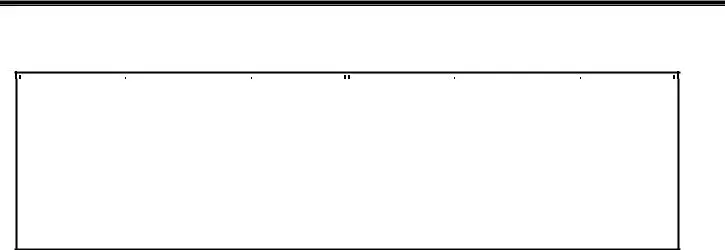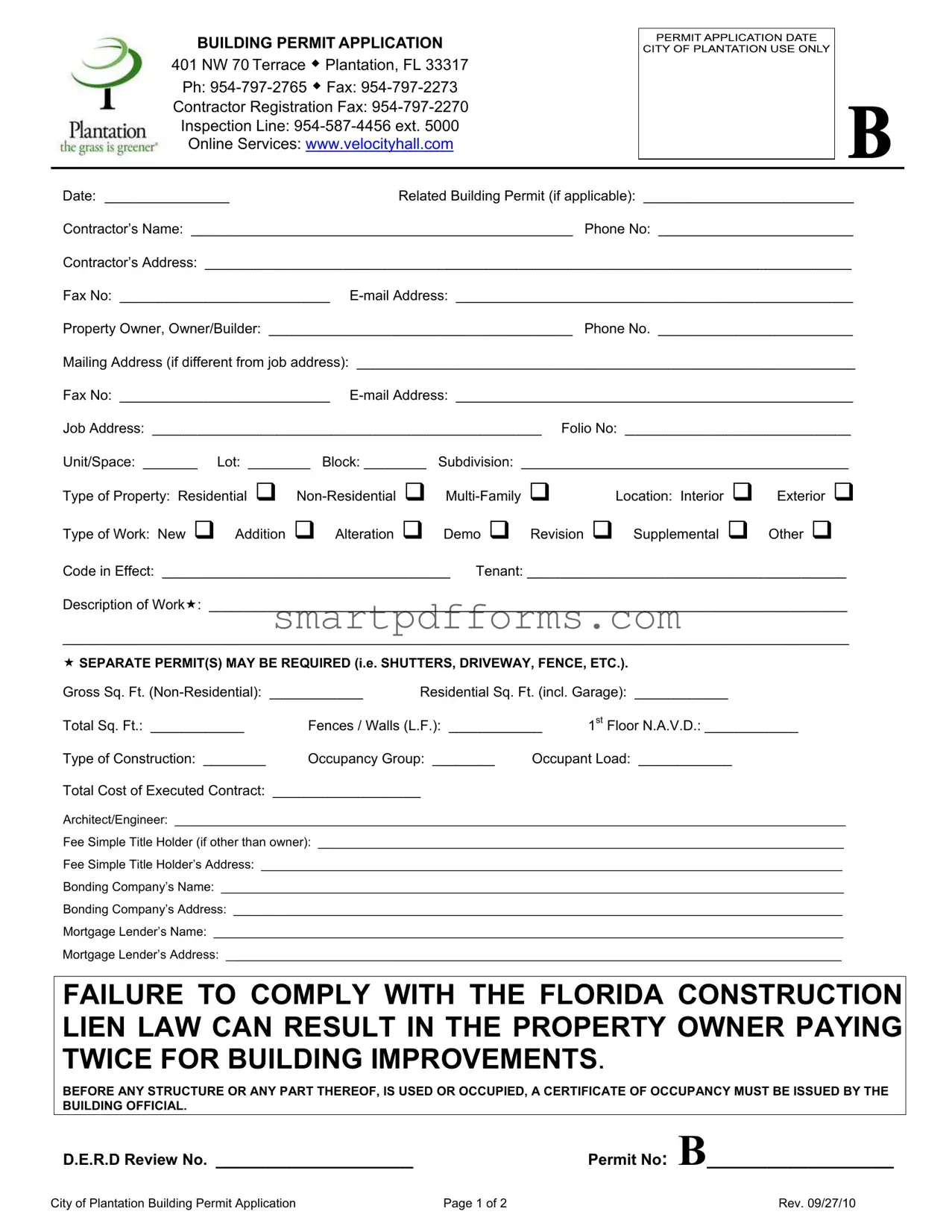BUILDING PERMIT APPLICATION
401 NW 70 Terrace Plantation, FL 33317
Ph: 954-797-2765 Fax: 954-797-2273
Contractor Registration Fax: 954-797-2270
Inspection Line: 954-587-4456 ext. 5000
Online Services: www.velocityhall.com
Date: ________________Related Building Permit (if applicable): ___________________________
Contractor’s Name: _________________________________________________ Phone No: _________________________
Contractor’s Address: ___________________________________________________________________________________
Fax No: ___________________________ E-mail Address: ___________________________________________________
Property Owner, Owner/Builder: _______________________________________ Phone No. _________________________
Mailing Address (if different from job address): ________________________________________________________________
Fax No: ___________________________ E-mail Address: ___________________________________________________
Job Address: __________________________________________________ Folio No: _____________________________
Unit/Space: _______ Lot: ________ Block: ________ Subdivision: __________________________________________
|
|
|
|
|
Type of Property: Residential Non-Residential |
Multi-Family |
Location: Interior |
Exterior |
Type of Work: New Addition Alteration |
Demo Revision |
Supplemental |
Other |
Code in Effect: _____________________________________ |
Tenant: _________________________________________ |
Description of Work: __________________________________________________________________________________
_____________________________________________________________________________________________________
SEPARATE PERMIT(S) MAY BE REQUIRED (i.e. SHUTTERS, DRIVEWAY, FENCE, ETC.).
|
|
|
|
|
Gross Sq. Ft. (Non-Residential): |
____________ |
Residential Sq. Ft. (incl. Garage): ____________ |
Total Sq. Ft.: ____________ |
Fences / Walls (L.F.): ____________ |
1st Floor N.A.V.D.: ____________ |
Type of Construction: ________ |
Occupancy Group: ________ |
Occupant Load: ____________ |
Total Cost of Executed Contract: ___________________
Architect/Engineer: _________________________________________________________________________________________________
Fee Simple Title Holder (if other than owner): ____________________________________________________________________________
Fee Simple Title Holder’s Address: ____________________________________________________________________________________
Bonding Company’s Name: __________________________________________________________________________________________
Bonding Company’s Address: ________________________________________________________________________________________
Mortgage Lender’s Name: ___________________________________________________________________________________________
Mortgage Lender’s Address: _________________________________________________________________________________________
FAILURE TO COMPLY WITH THE FLORIDA CONSTRUCTION LIEN LAW CAN RESULT IN THE PROPERTY OWNER PAYING TWICE FOR BUILDING IMPROVEMENTS.
BEFORE ANY STRUCTURE OR ANY PART THEREOF, IS USED OR OCCUPIED, A CERTIFICATE OF OCCUPANCY MUST BE ISSUED BY THE BUILDING OFFICIAL.
D.E.R.D Review No. ___________________ |
|
Permit No: B__________________ |
City of Plantation Building Permit Application |
Page 1 of 2 |
Rev. 09/27/10 |

IMPORTANT: Give notice for Inspections as per Florida Building Code 109.3 and 109.5; All approved plans, permit card and specifications MUST be on the job when an inspection is made; and Permit shall expire as per Florida Building Code 105.10.3 if construction is not begun or suspended.
NOTICE: In addition to the requirements of this permit, there may be additional restrictions applicable to this property that may be found in the public records of this county, and there may be additional permits required from other governmental entities such as water management districts, state agencies or federal agencies.
All city streets, sidewalks and curb damaged due to the construction shall be repaired to the satisfaction of the Public Works Department prior to issuing the Certificate of Occupancy. City properties on which earth spills or other debris falls shall be cleaned immediately. The owner of the building and the undersigned agree to conform to all applicable laws of this jurisdiction.
THE UNDERSIGNED APPLICANT DOES HEREBY:
Request that a building permit be issued to do the work and installations as indicated. I certify that no work or installation has commenced prior to the issuance of a permit, that all work will be performed to meet the standards of all laws regulating construction in the CITY OF PLANTATION whether specified in this application and accompanying plans or not, and that all the foregoing information is accurate. Furthermore, if I am not the person whose property may be subject to the Florida Construction Law, I promise, in good faith that the Construction Lien Statement furnished to me by the Building Department will be delivered by me to the person whose property is subject to the Lien Law and to the Attachment Proceeding authorized under it.
____________________________________________ |
_____________________________________________ |
Signature of Owner, Owner/Builder |
Signature of Contractor or Agent |
|
|
State Registration #: ______________________________ |
____________________________________________ |
Broward Comp./State Cert. #: _______________________ |
|
|
Signature of Notary Public, State of Florida |
|
|
|
|
____________________________________________ |
|
|
Signature of Notary Public, State of Florida |
____________________________________________ |
|
|
Stamp of Notary Public |
|
|
|
Personally Known |
Produced Identification |
____________________________________________ |
Type of Identification Produced: _____________________ |
Stamp of Notary Public |
|
Did Take an Oath |
Did Not Take an Oath |
Personally Known |
Produced Identification |
|
|
Type of Identification Produced: _____________________ |
|
|
Did Take an Oath |
Did Not Take an Oath |
Office Use Only
Conditions under Which Approved – P.A.C. required: Yes No |
H.O.A. required: Yes No |
|
DEPARTMENT |
|
|
APPROVED BY |
|
|
DATE |
|
|
|
|
|
|
|
|
|
|
|
ZONING |
|
|
|
|
|
|
|
|
|
|
|
|
|
|
|
STRUCTURAL |
|
|
|
|
|
|
|
|
|
|
|
|
|
|
|
ELECTRICAL |
|
|
|
|
|
|
|
|
|
|
|
|
|
|
|
MECHANICAL |
|
|
|
|
|
|
|
|
|
|
|
|
|
|
|
PLUMBING |
|
|
|
|
|
|
|
|
|
|
|
|
|
|
|
|
|
DEPARTMENT |
|
|
APPROVED BY |
|
|
DATE |
|
|
|
|
|
|
|
|
|
|
|
FIRE |
|
|
|
|
|
|
|
|
|
|
|
|
|
|
|
LANDSCAPE |
|
|
|
|
|
|
|
|
|
|
|
|
|
|
|
ENGINEERING |
|
|
|
|
|
|
|
|
|
|
|
|
|
|
|
UTILITIES |
|
|
|
|
|
|
|
|
|
|
|
|
|
|
|
|
|
|
|
|
|
|
|
|
|
Application Approval: _______________________________________________
* This Permit does not become valid until signed by the Building Official or an Authorized Representative.
Permit Fee: $__________________ |
Permit No: B__________________ |
City of Plantation Building Permit Application |
Page 2 of 2 |
Rev. 09/27/10 |


